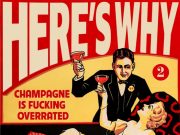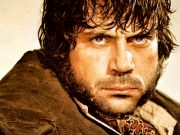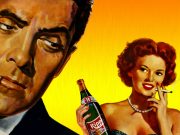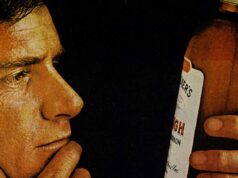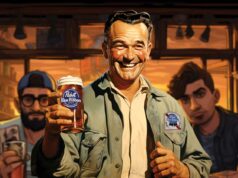With the exception of a few goofy teetotalers, in the average Old West town you couldn’t swing a dead cat without hitting a serious tippler (and he’d probably shoot you soon after). The drinkers you’re about to cross paths with—con-men, gunslingers, gamblers, madams, lawdogs and soiled doves—are among the very best.
THE GOOD…
Wild Bill Hickok (1837-1876)
 Law man, gunfighter, Union Army spy, military scout, dime-novel hero and dangerous poker player, James Butler Hickok was born in Troy Grove, Illinois. His youth was characterized by a love of guns, a cheerful fondness for “medicinal” whiskey, and a near-total disregard for authority. He left home in his teens to escape the authoritarian rule of his fiercely Baptist parents (they wanted him to wear a suit to church!), and headed west, where he figured he could carve out a life that accorded with his own singular set of values.
Law man, gunfighter, Union Army spy, military scout, dime-novel hero and dangerous poker player, James Butler Hickok was born in Troy Grove, Illinois. His youth was characterized by a love of guns, a cheerful fondness for “medicinal” whiskey, and a near-total disregard for authority. He left home in his teens to escape the authoritarian rule of his fiercely Baptist parents (they wanted him to wear a suit to church!), and headed west, where he figured he could carve out a life that accorded with his own singular set of values.
After bumming around Missouri for a time, Hickok found work as a stagecoach driver on the Oregon Trail. It was a good gig, until his coach broke down, leaving Bill and his passengers stranded. Bill sought peace with a bottle of “medicine” and passed out in a patch of creosote. As it wasn’t his custom to bathe regularly, his aroma was palpable to people at ten paces. It was palpable to bears at somewhat greater distances, as Bill found out when a particularly peckish example of the species took a large bite out of his right ass cheek.
Unable to find his pistols in the dark, Bill went after the critter with a skinning knife. The commotion alerted the passengers, who rushed over to find a very dead bear and a mostly-dead Bill Hickok. They asked how they could help, and Hickok asked for all the whiskey they could lay their hands on. He poured one bottle on his various wounds, another in his stomach, and passed out again. A fresh coach arrived the next day and Bill road it back to Missouri, where he announced that driving a stagecoach had lost some of its luster.
In 1865, Hickok, now well-known as “Wild Bill,” traveled back east to Chicago in the company of several dime-novel scribblers. He’d always wanted to see a city the size of Chi-Town, and he’d heard that good whiskey could be had there. Hickok’s writer chums took him to a local tavern one evening for drinking and billiards. Word of Wild Bill’s arrival spread quickly and he was soon surrounded by fans eager to hear his stories and buy him liquor, and Hickok wasn’t one to turn down free whiskey. The small throng attracted the attention of the neighborhood’s resident gang of thugs, and five of them, each a street-hardened fighter, sauntered over to investigate the hubbub.
Hickok’s frontier clothing—a floppy leather hat atop his mane of long blond-brown hair, buckskins, leathers, moccasins—amused the thugs immensely. They ridiculed Hickok, insulting his clothes, his hair, and his drooping moustaches. For a time, Bill let their taunts slide. All he wanted to do was get sozzled and have fun. Then one of the ruffians asked Bill if every bumpkin on the plains picked his teeth with a Bowie knife. Bill tipped his hat back and said, quite calmly, “No, but we all know who our mothers are.”
Bill’s observation left the thugs feeling a tad affronted, a condition for which their limited cranial dexterity knew only one cure: Kill.
As the five hooligans rushed Hickok, he doffed his hat and turned his pool cue heavy-end-up. About 15 seconds later, Hickok stepped across the five broken, bleeding thugs, and resumed his drinking, picking up the story he’d been telling right at the point he’d left off. The writers would later inflate the number of attackers to eight, then ten, but still—taking out five angry assholes armed with nothing but a billiard stick, and doing it while pie-eyed on good Chicago whiskey, ranks as quite an accomplishment.
Sam Houston (1793-1863)
 Though born in Virginia’s Shenandoah Valley in 1793, Sam is best known as a Texan. He was President of the Republic of Texas, then, after statehood, a Senator, and later was elected governor of the state. Additionally, Sam was a soldier of note, fighting in the War of 1812, and later becoming Major General of the Texas Army. In 1836, he fought in defense of the ill-fated Alamo, then regrouped and defeated Mexican general Antonio Lopez de Santa Anna at the Battle of San Jacinto. The city of Houston is named after him, as is Fort Sam Houston, and Sam Houston State University.
Though born in Virginia’s Shenandoah Valley in 1793, Sam is best known as a Texan. He was President of the Republic of Texas, then, after statehood, a Senator, and later was elected governor of the state. Additionally, Sam was a soldier of note, fighting in the War of 1812, and later becoming Major General of the Texas Army. In 1836, he fought in defense of the ill-fated Alamo, then regrouped and defeated Mexican general Antonio Lopez de Santa Anna at the Battle of San Jacinto. The city of Houston is named after him, as is Fort Sam Houston, and Sam Houston State University.
Sam Houston also drank like six fish.
While on business in Washington D.C., he became embroiled in a nasty feud with Ohio congressman William Stanbery. They sniped back and forth until one fateful day in 1830, when Sam finally became fed up. Sam spent an appreciable number of hours in consultation with his whiskey jug, then set out on foot to confront Stanbery. He found the man on Pennsylvania Avenue. The pair exchanged words, prompting Houston to lay into his nemesis with a hickory walking stick and beat him to a bloody pulp.
Considered a friend by the Cherokee people, Houston lived with them for a time, where he acquired the name “Raven.” However, he drank so much, and so often, while living among the tribes that he picked up another name: “Big Drunk.” His drunken behavior was so unabashedly energetic—singing, dancing, whooping it up—that several tribal elders decided Sam must be part Indian. Houston explained that, no, he had no Indian blood, he was just, well, enthusiastic about liquor.
Sam Houston’s name lives on. Sometimes that’s a good thing; other times, not so much. On the good side, the McLain & Kyne Distillery in Kentucky offers a tasty 10-year-old, small-batch whiskey called Sam Houston. On the bad side, his namesake university in Texas is the host institution for a nationwide program aimed at “changing America’s drinking culture.”
If Sam were alive today, I’m sure he’d put that hickory walking stick to good use.
Jim Bridger (1804-1881)
 Mountain man, military scout, teller of outrageous tales, and noted drunkard, Bridger guided the first mapping expedition of the region now known Yellowstone National Park. It was Bridger himself who discovered the geysers and sulphurous mud pits that made the place famous, but no one believed him, and for years maps of the area were labeled “Bridger’s Lies.”
Mountain man, military scout, teller of outrageous tales, and noted drunkard, Bridger guided the first mapping expedition of the region now known Yellowstone National Park. It was Bridger himself who discovered the geysers and sulphurous mud pits that made the place famous, but no one believed him, and for years maps of the area were labeled “Bridger’s Lies.”
Bridger believed that whiskey was healthy for a man, and distrusted “water drinkers.” An inventive fellow, he concocted his own blend that became a favorite among his surveying cronies. The main ingredient was simple Missouri Valley whiskey, but Bridger seasoned it with red pepper, rattlesnake heads, and chewing tobacco.
At the 1835 Rendezvous at the confluence of Horse Creek and the Green River, Jim began complaining about a pain in his shoulder, where he’d been wounded by an arrow three years earlier. There happened to be a doctor on hand, one Marcus Whiteman, who explained that part of the arrow was still lodged under the skin. At Bridger’s insistence, Dr. Whiteman set to work with a scalpel and a pair of pliers.
The best, in fact only, anesthetic available was whiskey. Dr. Whiteman splashed some on Bridger’s shoulder, and Bridger splashed some down his throat. He continued splashing right on through the procedure, which entailed Dr. Whiteman cutting through tissue, muscle, and a hard layer of calcium that had built up around the foreign object, which indeed turned out to be a three-inch arrowhead. Bridger continued drinking while he was stitched shut, then took the arrowhead and hung it around his neck on a leather lanyard. Witnesses claimed that the only sound Bridger made during the whole operation was the occasional whiskey belch.
Bridger and his thirst were the center of attention again two years later, at the 1837 Rendezvous. He met up with an old comrade, Capt. Sir William Drummond Stewart, a Scottish lord at large in the frontier collecting animals for a game park he hoped to start back home. The two friends shared a bottle and Drummond presented Bridger with a gift: a full suit of antique plate mail from Scotland. Bridger, good and ripped, donned the armor, including the shield and lance, and spent a merry afternoon “jousting” his fellow trappers.
Being chased around in the heat and stabbed repeatedly in the ass by a huge, drunken maniac in plate mail soon got on everyone’s nerves, and they decided to “settle” Jimmy down a touch. Jimmy, however, was a man who, when in his cups, would very likely refuse to “settle” if settling was not immediately on his mind. It eventually required over a dozen mountain men and trappers, not to mention the assistance of a largish rock, to unhorse Bridger, wrestle him out of the armor, and render him unconscious. The big man awoke a few hours later, headachy and in a snit, and went right after a fresh bottle of bug juice. In no time he was back in his mail, mounted, and galloping through camp, lance at the ready. The others let Jimmy be this time. Subduing him once had been too large an effort.
Bridger’s later travels led him into the Utah Territory, as a guide for a band of Mormon settlers. He didn’t get on with them very well, as they took a dim view of his hygiene and drinking habits, and he took a dim view of their dim views. He quickly ran out of whiskey and had no way of replenishing his supply, a state of affairs that essentially ruined his mood and the moods of everyone who came within a quarter-mile of him. Knowing he wouldn’t be able to buy more whiskey until spring, he made it known among his Mormon charges that he would pay $1,000 in gold for the first bushel of corn they raised. His offer went unfulfilled, though, when the Mormons realized that Bridger’s intentions had nothing to do with bread and everything to do with distilling a batch of sour mash.
Jim Bridger spent a very dry winter with some very dry people, departed on the first warm day in March, and vowed never to set foot in Utah ever again.
Poker Alice (1853-1930)
Poker Alice was born Alice Ivers on February 17, 1853 in Devonshire, England. She picked up her nickname while living in the rough and tumble mining town of Leadville, Colorado, after her husband, Frank Duffield, a part-time mine engineer and wannabe card sharp, died in a cave-in.
Looking for a means of support, Alice turned to poker. She made a name for herself as a card-playing beauty, with the best poker face in the West. Witnesses said her expression never changed once she took her seat at a table, even with a six-shooter pointed between her eyes. When she joined a game she would toss back a shot of whiskey and holler, “Praise the Lord and place your bets and I’ll take your money with no regrets!” On a good night, Alice might take home better than $6,000. On one occasion she broke the bank in Silver City in less than four hours. She spent her money on excellent meals and tailored dresses, sometimes traveling all the way to New York City for week-long spending sprees. While there, she shunned “polite” society, preferring to mix with “her people” in saloons and gaming halls.
Alice took her whiskey neat, something that discomfited male gamblers almost as much as her formidable gaming skills. After she drank several arrogant men under the table (and took all their money), word got around and guys stopped challenging her to drinking contests. She carried a .38 revolver in her skirts, something everyone knew because she wasn’t the least shy about drawing it, once killing a man who wouldn’t back down. (Again her expression never changed, even as she pumped three bullets in his chest.) In her later years, while dealing faro in Deadwood, she developed a taste for cigars, smoking one after another while she managed the game. Around this same time, she came to loathe cheap whiskey and quickly assembled her own bootlegging operation, teaching herself the particulars of the business and producing an abundance of superior hooch.
Throughout the twists and turns of her life (she married and buried three husbands and raised seven children), Poker Alice maintained her boarding-school manners and a crisp command of the Queen’s English; something like Mary Poppins, except instead of an umbrella she carried a six-shooter and a whiskey flask.
THE BAD…
Soapy Smith (1860-1898)
 Jefferson Randolph Smith II was a bunko artist of exquisite talent and bravado. Born in Georgia in 1860, Soapy set out for Texas as a young man, setting up shop in Ft. Worth. By the time he high-tailed it out of town with a posse close behind, Texas had enacted several laws aimed specifically at Soapy and his grifting ways.
Jefferson Randolph Smith II was a bunko artist of exquisite talent and bravado. Born in Georgia in 1860, Soapy set out for Texas as a young man, setting up shop in Ft. Worth. By the time he high-tailed it out of town with a posse close behind, Texas had enacted several laws aimed specifically at Soapy and his grifting ways.
Over the next few years he carved a criminal swath through the western territories. In Creede, Colorado, he owned a saloon and worked his schemes from a stool at the end of the plank-board bar, where he could keep an eye on his liquor supply and his fixed faro tables. When things got too hot in the mountains, he skedaddled to Denver, where he opened the Tivoli Club right across the street from the busiest train station in the west. Before long he had dozens of men in his bunko gang and declared himself the King of the Denver Underworld. A short time later he was elected Sheriff, and steadfastly refused to arrest himself for watering whiskey.
When things went bad for him again, legal-wise, Soapy headed north, and landed in Skagway, Alaska. He opened several saloons in the little town and one, Jeff Smith’s Parlor, became known as the Unofficial Skagway City Hall. Whiskey shots cost a nickel. Good whiskey cost 50 cents. The best whiskey, Soapy’s whiskey, wasn’t for sale. It was Soapy’s, and he didn’t like to share.
Smith died in 1898 in Juneau, after arguing with city surveyor Frank Reid. It’s unclear who shot first, but Soapy died on the spot and Reid 12 days later. Whiskey shots, even the good stuff, were poured free of charge the next day at all of Soapy’s saloons.
Doc Holliday (1851-1887)
 John Henry Holliday was born in Georgia in 1851. An educated man, John learned mathematics, the sciences, and earned a degree in dentistry (hence his nickname, “Doc”). He disliked the teeth trade, preferring to spend his time playing poker, and after being diagnosed with tuberculosis, he went west to partake of the dry climate.
John Henry Holliday was born in Georgia in 1851. An educated man, John learned mathematics, the sciences, and earned a degree in dentistry (hence his nickname, “Doc”). He disliked the teeth trade, preferring to spend his time playing poker, and after being diagnosed with tuberculosis, he went west to partake of the dry climate.
Despite his genteel upbringing, what Doc really liked to do was have a good time. His idea of a good time involved gambling on cards, drinking whiskey, and enjoying the attentions of a lady or two. A really good time featured all three at once. It has been said that he drank three quarts of whiskey on an average day, and when he got serious about the job, could kill five or six.
Together with his occasional paramour, “Big Nose” Kate Elder, Holliday went on a violent, lucrative, and whiskey-soaked spree through the territories. He tended to leave town under threat of arrest or one step ahead of a posse, and at one time was wanted for various crimes in Kansas, Texas, Missouri and Arizona. He holed up for a time in Tombstone, Arizona, arriving shortly before the Earp brothers, with whom he became embroiled in the animosity which led to the gunfight at the OK Corral.
His TB worsened, causing him to regularly cough up blood. Strong whiskey seemed to stem the hacking, so Doc drank from dawn to dusk. He checked into a hospital for consumptives in Glenwood Springs, Colorado, where, as a wealthy man, he bribed nurses to bring him his self-prescribed medicine. Otherwise, he remained a model patient until he died. He was 36 years old.
Mattie Silks (1848-1929)
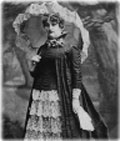 Mattie wasn’t really bad, at least not in the sense that other Western characters could be bad, but she was a professional madam and, like any woman involved in the cathouse trade, was given the high hat by “decent” citizens. A devilishly clever business woman, she ran bordellos in the Colorado mining camps of Georgetown and Leadville, and three simultaneously in Denver’s red-light district, including the infamous House of Mirrors, the most opulent brothel west of the Mississippi. The sign above the door read: Men Taken In And Done For.
Mattie wasn’t really bad, at least not in the sense that other Western characters could be bad, but she was a professional madam and, like any woman involved in the cathouse trade, was given the high hat by “decent” citizens. A devilishly clever business woman, she ran bordellos in the Colorado mining camps of Georgetown and Leadville, and three simultaneously in Denver’s red-light district, including the infamous House of Mirrors, the most opulent brothel west of the Mississippi. The sign above the door read: Men Taken In And Done For.
One day Mattie got all giggly over a chap named Cort Thompson, a handsome man newly arrived in Denver to make some money doing what he did best—running footraces. Denverites, like all Westerners, were eager to gamble on any sort of athletic competition, and the betting was spirited. Mattie bet heavily on Cort, and had to carry her loot home bunched in her dress. She invited all of Denver to a party that night at the posh Olympic Gardens—“Champagne for one and all, until we drink the whole lot!”—and when the bubbly ran out, Mattie told her guests to keep drinking, instructing the bartender to put it all on her credit line. Cort Thompson took a shine to cute, pudgy little Mattie, and in no time they were the hottest item in the red light district.
But not everyone, it seems, was thrilled for them. Unbeknownst to Cort or Mattie, Cort had captured the amorous attentions of another local madam, Katie Fulton. While the actual flow of events from this point is hazy, the upshot is that Katie Fulton’s ceaseless pursuit of Cort Thompson finally sent all five-feet zero-inches of Mattie Silks into a howling frenzy that culminated on August, 5th, 1877, when, in front of half the city, Mattie Silks and Katie Fulton faced off in the first-ever gun duel fought between two women (that we know of).
They stood back-to-back in the middle of Market Street, walked the traditional ten paces, wheeled around and started blasting away. They missed each other entirely, much to the crowd’s amusement, but Katie managed to shoot one of the bystanders—Cort Thompson. Thompson lived, however, while Katie Fulton was driven out of Denver, never to return.
After tending to Cort’s wound, Mattie invited the crowd to the House of Mirrors for free drinks, good music, and dancing until dawn. It is said that her girls offered discounts, but the sources were probably drunk at the time.
Julia Bulette (c. 1838-1868)
 Julia Bulette, owner of Julia’s Place, an elegant, wildly expensive parlor house in Virginia City, Nevada, was the unrivaled Queen of the Comstock Lode. Most of her early history is shadowy. She might have been born in New Orleans, or Leeds, England, or Mars, for that matter—Julia kept her past to herself. By all accounts, her work as a “prairie frail” took her all over the West, and, if you believe the stories, her skill with a derringer was second only to her way with a whiskey cork.
Julia Bulette, owner of Julia’s Place, an elegant, wildly expensive parlor house in Virginia City, Nevada, was the unrivaled Queen of the Comstock Lode. Most of her early history is shadowy. She might have been born in New Orleans, or Leeds, England, or Mars, for that matter—Julia kept her past to herself. By all accounts, her work as a “prairie frail” took her all over the West, and, if you believe the stories, her skill with a derringer was second only to her way with a whiskey cork.
Her first rule of business, as well as her personal philosophy, can be summed up as “Only the Best.” She wore the best dresses, the classiest perfume, and the priciest jewelry. Her parlor house (referred to by the locals as Julia’s Castle) featured an eye-popping array of imported finery. Her girls dressed to rival any banker’s wife, much to the chagrin of Virginia City’s stuffy upper class, and she provided her customers with a staggering bonanza of potent potables, importing exceptional brands from all over the world. She enjoyed treating her friends to a fine drunken evening, which the liquor bills alone regularly cracked the $300 mark. Without a doubt, Julia’s Castle was the finest establishment of its kind for five hundred miles in any direction.
Only the richest of the rich could afford to patronize the Castle. If you only drank and did nothing else, an evening might run $40 (that’s over $800 in today’s dollars). Going whole hog could result in a tab running well into the hundreds. And if you chose to go whole hog and book an evening with Julia herself, well, best bring your wallet—at the height of her popularity, Julia commanded a $1000 a night.
On January 19th, 1867, Julia was murdered by one of her customers, a French gambler named Jean Marie A. Villain. It is a testament to Julia’s popularity that on the day of her funeral, all Virginia City businesses closed in her honor. Close to 5,000 people attended her funeral, including her close friend, Mark Twain.
More recently, McCormick Whiskey paid Julia Bulette a great compliment when they produced a whiskey decanter in her likeness. It’s a fitting memorial to the Queen of the Comstock, even if it is rather small and not very expensive.
…AND THE THIRSTY
Six-Toed Pete (Dates Unknown)
A peripheral figure in most history books, Six-Toed Pete (real name unknown) wandered the west as a part-time gunslinger and full-time whiskey drinker. He wasn’t that hot of a gunfighter (why do you think he had only six toes?) and not much  better as a tippler. To wit: he went on a week-long bender in Jefferson City, Nebraska, near the end of which he staggered into the Black Bull Saloon and ordered a bottle of rye and a cheroot. After a few shots he attempted to light his smoke using a brand from the wood stove. Things went sideways for Pete when he exhaled instead of inhaled. His rye-saturated breath exploded into a cloud of fire that burned off his beard, moustache, eye brows, most of his hair, and did harm to a perfectly serviceable hat. Pete might have lived down the fire and its results were it not for the fact that his drinking companion panicked and doused the flames by upending a spittoon over Pete’s head. On the bright side, Pete’s good friend, Wild Bill Hickok, bought him whiskey throughout his recovery.
better as a tippler. To wit: he went on a week-long bender in Jefferson City, Nebraska, near the end of which he staggered into the Black Bull Saloon and ordered a bottle of rye and a cheroot. After a few shots he attempted to light his smoke using a brand from the wood stove. Things went sideways for Pete when he exhaled instead of inhaled. His rye-saturated breath exploded into a cloud of fire that burned off his beard, moustache, eye brows, most of his hair, and did harm to a perfectly serviceable hat. Pete might have lived down the fire and its results were it not for the fact that his drinking companion panicked and doused the flames by upending a spittoon over Pete’s head. On the bright side, Pete’s good friend, Wild Bill Hickok, bought him whiskey throughout his recovery.
Big Nose Kate (1850-1940)
Known at various times as Kate Fisher, Kate Elder, or Kate Cummings, Mary Katherine Haroney was born in Budapest, Hungary, the oldest child of a wealthy physician. Her father moved to Mexico in 1862 to act as the personal physician for Emperor Maximilian I. In 1865, when the Mexican government imploded, the Haroney family relocated to Davenport, Iowa, where Dr. and Mrs. Haroney managed to die within the year, leaving Kate an orphan.
The intervening years are a blur, but by 1874 Kate was living in Dodge City, Kansas, where she sold her charms in a brothel owned by Nellie Earp, wife of James Earp, the less famous older brother of Virgil, Morgan and Wyatt. While living in Dodge, Kate met Doc Holliday, who would be part of her life for many years.
Kate could match Doc drink for drink, and her temper was, if anything, even more volatile than his. She carried a derringer in an ankle holster, and when crossed, could curse a trailhand back into church. After she’d had a few, her verbal tirades took on a cosmopolitan flavor as she assaulted her opponents in a hair-raising potpourri of Hungarian, French and English. Many times, sadly, when Kate slipped into banshee-mode, her target was Doc Holliday.
They were quite the couple. The phrase “love birds” can share space in the same sentence as the words “Doc” and “Kate” only as a means of defining what they absolutely were not. We’ve all had friends like Holliday and Big Nose (hopefully without the shootings and stabbings), or witnessed their like. You know, they start the night acting like Siamese twins attached at the lips, drinking and dancing without a care in the world, then, for reasons even they probably don’t understand, they spend the next few hours auditioning for the Springer show—yelling, chasing, crying, slapping, pouting—until, just at the very apogee of ugliness, they make up and sneak off to screw in the laundry room. Such was the daily reality of Kate’s relationship with Doc Holliday.
Kate’s epic drinking habits once got her and Holliday in a whole hill of trouble. They had been fighting and Kate, in a cloud of rage, went to a saloon, where she encountered Tombstone sheriff Johnny Behan. He was sitting with members of the feared outlaw gang, the Cowboys, lead by a rancid little psycho called Curley Bill Brocious and his frequent partner in crime, the gunman Johnny Ringo. (At a saloon in Prescott, Arizona, Ringo, a specialist at shooting unarmed men, offered to buy a man a whiskey, but when the man ordered a beer instead, Ringo shot him dead.)
The Cowboys were involved in a feud with the Earp brothers and Doc Holliday, a feud that Sheriff Behan encouraged because he was a weasel and felt threatened by the Earps’ influence in “his” town. When Kate thundered into the saloon, the boys saw an opportunity. Someone, surely one or more of the Cowboys, had recently robbed a Wells-Fargo wagon and murdered the driver. The Cowboys and Behan bought Kate as much whiskey as she could drink and persuaded her to swear that it was Doc Holliday who had done the deed, which she did right on the spot.
Kate recanted after she sobered up. Doc forgave her, and their relationship continued along it usual tempestuous course until Doc finally became so ill he required hospitalization. They never saw each other again, and Kate returned to Arizona, where she lived well into her 90s.
The building that was once the Grand Hotel in Tombstone is, today, Big Nose Kate’s Saloon. Numerous visitors have claimed that Kate’s ghost haunts its back rooms and corridors. Big Nose Kate was a hellion in life, a free spirit, an ass kicker and a name taker, so her lingering spirit is likely one spitfire of a spook.
Judge William C. Heacock (Dates Unknown)
In the 1880s, Judge William C. Heacock was the law in Albuquerque, New Mexico—he wrote it, enforced it, and adjudicated it. When not reading legal doom to rambunctious waddies or thinking up new offenses requiring hefty fines (of which he received a percentage), Judge Heacock’s favorite pastimes were swilling whiskey and dealing three-card monte in the back room of the saloon where he conducted court.
As a three-card monte dealer, Judge Heacock was better than average, but even gamblers who know what they’re doing occasionally get hosed by the fickle fates. Such was Judge Heacock’s lot one afternoon in 1883 as he sat drinking and dealing. He was surrounded by marks eager to hand over their wages, but a bad run of luck had left him utterly bereft of funds. Annoyed, he sent for his deputies, who were drinking out front in the saloon, and ordered them to go arrest a drunk. And not just any ol’ drunk, mind: a drunk with money. The deputies returned a short while later, dragging a man with them. The ensuing conversation went something like this:
Judge: Is he drunk?
Deputy: He’s dead, sir.
Judge: Dead drunk?
Deputy: Plain ol’ dead, sir.
Judge: Explain yourself.
Deputy: He died up there, sittin’ at the bar. People wanted us to take him away.
Judge: You imbecile. This is a court of law. How am I to have an inquest?
Deputy: Couldn’t say, sir.
Judge: Well, the writ of habeas corpus is there for a reason. Bring the accused forward.
Deputy: What’s the charge, sir?
Judge: Never mind that for now. Did you frisk the man?
Deputy: Here and there, sir.
Judge: Does he have any money?
Deputy: A little better than 20 dollars, sir. And some pennies, sir.
Judge: Splendid. (Addressing the corpse.) What have you to say for yourself? Well? Talk, man! (Raps his whiskey glass on the table like a gavel.) Your arrogant silence leaves me no choice but to find you in contempt of court. For that you will pay a fine and court costs to the tune of 20 dollars. (More rapping with the glass.) Court is adjourned. Since it’s too late to call the undertaker, haul the prisoner out to the shed before he starts to ripen.
Judge Heacock, armed now with a crisp 20-dollar bill, went back to his game and his bottle. Witnesses say he won big.
Judge Roy Bean (c. 1825-1903)
 Roy Bean (who’s given first name was Phantly—yeah, I would’ve changed it too) was born in Mason County, Kentucky sometime around 1825, but records are sketchy. At 15 he followed his older brothers Sam and Josh west, seeking adventure. He joined a wagon train bound for New Mexico and points south, and opened a trading post and saloon in Chihuahua, Mexico.
Roy Bean (who’s given first name was Phantly—yeah, I would’ve changed it too) was born in Mason County, Kentucky sometime around 1825, but records are sketchy. At 15 he followed his older brothers Sam and Josh west, seeking adventure. He joined a wagon train bound for New Mexico and points south, and opened a trading post and saloon in Chihuahua, Mexico.
Roy was his own best customer, sampling the stock with gusto, and was usually the main troublemaker in his own place. One such dust-up ended with Roy killing a man. Rather than face any irritating consequences, Roy closed his saloon, loaded as much leftover liquor as possible on a mule, and high-tailed it to San Diego, California, where his brother, Josh, had recently been elected Mayor.
The Beans took care of their own, and in 1849 brother Josh appointed Roy to the rank of lieutenant in the California state militia. Josh also owned a saloon called the Headquarters and hired Roy as its full-time bartender. Again, Roy out-drank his customers, earning a reputation as a foul-mouthed rascal and braggart. He also took to swaggering drunkenly around town in a sombrero and embroidered Mexican pants, and waving a pair of six-guns. Before long, Roy’s temper ended in another dead guy, and he fled east to San Antonio, Texas.
In Texas, Roy set up shop as a whiskey seller (people said he watered his liquor) and sold firewood he illegally cut on private land. He married a 15-year-old Mexican girl, who aided him in his various semi-criminal enterprises. Roy drank his whiskey, sold his firewood, and enjoyed a relatively trouble-free life. He managed not to kill anyone and was never thrown out of his own saloon for being a disorderly pain in the ass. Still, he hated being tied down—to one location and one wife—and began casting around for something else to do. He found it in 1882 when the railroad announced plans to run tracks between San Antonio and El Paso—a span covering over five hundred miles of brutal Chihuahuan Desert. Roy ditched his wife and businesses, and set up a tent saloon in Vinegaroon, Texas, to make money off railroad workers.
Vinegaroon attracted many outlaws and miscreants, and became a popular spot for Texas Rangers to round up the suspects. Problem was, the nearest courtroom was a week’s ride away. Sensing the need for local law enforcement, Roy, who’d never had more than a month’s formal education, decided he was just the man for the job. After some arm twisting and free bar tabs, the Pecos County commissioners appointed Roy Justice of the Peace.
He relocated to the slightly larger town of Langtry, Texas, and opened a saloon called the Jersey Lilly. Two signs above the door read Ice Beer and Law West of the Pecos. The Lilly served as Roy’s courtroom, and the butt of his pistol his gavel. His legal guide was a mangled copy of the Revised Statutes of Texas, 1879. He received occasional updates, but used them to light cigars or as toilet paper. The Lilly’s other main attraction was a large black bear, named Bruno, who lounged by the front doors growling at newcomers and drinking whiskey from a bowl.
“Judge” Roy Bean died in 1903. He went to Del Rio for a bender and died peacefully in his sleep.¸
—Richard English
(Note: the Author is indebted to the works of Michael Rutter, T.J. Stiles, Frank Waters, Casey Terfertiller, Jan MacKell, Mary Franz, Linda R. Womack, Jan Murphy, Gladys R. Bueler, Ken Jessen, Valerie Green, and Phil Goodstein.)



